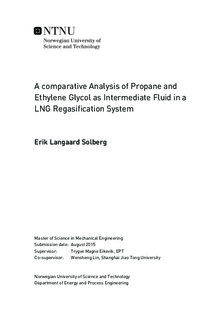A comparative Analysis of Propane and Ethylene Glycol as Intermediate Fluid in a LNG Regasification System
Master thesis
Permanent lenke
http://hdl.handle.net/11250/2381121Utgivelsesdato
2015Metadata
Vis full innførselSamlinger
Sammendrag
A LNG regasification system with intermediate fluid vaporizer is studied. Two different intermediate fluids (IF), propane and a mix of mono-ethylene glycol and water, are compared for use in the system. The regasification system consists of two tube-in-tube heat exchangers, where the IFs flow between the two. Liquid nitrogen (used instead of LNG for safety and practicality) is evaporated and heated in the cold side heat exchanger by the IF, while water heats the IF in the second, warm side heat exchanger. Neither IF change phase during the loop.
The work presented is conducted at the Shanghai Jiao Tong University in China. A small-scale rig is built in the campus laboratory and experiments are conducted with the two IFs. Simultaneously computer simulations with Ansys FLUENT are verified by the experiments. The thesis presents a relevant background for LNG terminals and import in China and explains the fundamental mathematics used by the simulation software. The simulation, including building geometry and mesh grids, conducting independence studies, setting up the simulation case and boundary conditions, solving and reaching convergence are thoroughly explained. The experiment build and performance is outlined as well, and is further detailed in the appendices.
The simulations, when verified by experiments, are used to compare propane and glycol as heat transfer fluids under exactly equal conditions. The comparison is discussed in relation to industrial-scale regasification plants and some recent scientific papers. The restrictions and differences of the IFs impact the use in different cases. Furthermore the overall regasification system is subject to discussion as well. It is found that more research is needed to further develop the overall system.
